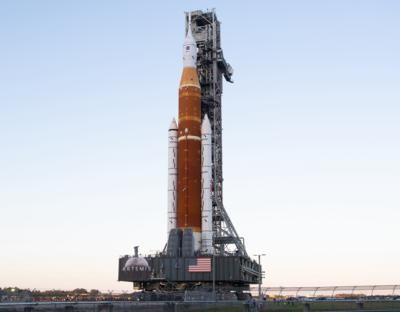Tue, Sep 27, 2022
Tropical Storm Ian Precludes 27 September Liftoff
The launch of Artemis I—the inaugural mission of NASA’s five-flight Artemis lunar program—has been postponed for a third time. The most recent postponement is attributed to concerns over Tropical Storm Ian, which is making its way northwest at a rate likely to see it near enough Florida’s Cape Canaveral area to pose unacceptable risk to United Launch Alliance’s SLS Rocket on its planned, 27 September launch date.

After meeting on Saturday, 24 September, and electing to scrub the launch, NASA flight directors instructed ground personnel to prepare the SLS rocket-stack to be removed from launch-pad 39-B and rolled back into the Kennedy Space Center’s Vehicle Assembly Building (VAB)—the 129,428,000-cubic-foot structure in which NASA engineers and technicians integrate boosters and spacecraft into cohesive vehicles and stack them onto mobile launch platforms in preparation for crawler transport to one of the Cape’s three launch-pads.
By dint of atmospheric data provided by the U.S. Space Force, the National Hurricane Center, and the National Oceanic and Atmospheric Administration, Artemis Program officials will presently render their final decision to either return the SLS rocket to the Vehicle Assembly Building or leave it to ride out the storm on the launch-pad. Should NASA brass so choose, the process of rolling the rocket back inside the VAB would commence late Sunday (25 September), or early Monday (26 September). Once underway, the crawler by which the SLS is transported can take up to ten-hours to make the 4.2-mile (6.8-kilometer) trip from launch-pad 39-B back to the VAB.
Left upon the launch-pad, the SLS rocket stack is capable of withstanding winds up to 85-miles-per-hour (74.1-knots). However, once saddled-up on a crawler and enroute the VAB, the SLS cannot survive winds higher than 46-miles-per-hour (40-knots).

Despite NASA officials having identified an early October launch window for the star-crossed Artemis I mission, it remains unlikely that a new launch date will be formalized until the pending rollback decision has been made. In a press release, NASA stated: “The agency is taking a step-wise approach to its decision making process to allow the agency to protect its employees by completing a safe roll in time for them to address the needs of their families while also protecting for the option to press ahead with another launch opportunity in the current window if weather predictions improve.”
Among the more interesting limitations by which the Artemis I launch is constrained is a prohibition against flying through precipitation. Subject limitation is designed to circumvent the SLS encountering natural lightning, or engendering rocket-triggered lightning strikes—both of which can cause damage to the SLS and endanger public safety. Rocket-triggered lightning forms when a large launch vehicle flies through an atmospheric electric field of sufficient strength to generate a static discharge.
More News
Dave Juwel's Aviation Marketing Stories ITBOA BNITBOB ... what does that mean? It's not gibberish, it's a lengthy acronym for "In The Business Of Aviation ... But Not In The Busine>[...]
The Pilot Attempted Several Times To Restart The Engine And Diverted To Long Beach Airport/Daughtery Field On October 20, 2025, about 1603 Pacific daylight time, an experimental am>[...]
Hazardous Weather Information Summary of significant meteorological information (SIGMET/WS), convective significant meteorological information (convective SIGMET/WST), urgent pilot>[...]
"The latest development underscores the government of Malaysia’s commitment in providing closure to the families affected by this tragedy..." Source: From statements made by >[...]
Also: IAE Acquires Diamond Trainers, Army Drones, FedEx Pilots Warning, DA62 MPP To Dresden Tech Uni The danger to the flight training industry and our future pilots is clear. Dona>[...]
 Aero-FAQ: Dave Juwel's Aviation Marketing Stories -- ITBOA BNITBOB
Aero-FAQ: Dave Juwel's Aviation Marketing Stories -- ITBOA BNITBOB NTSB Prelim: Rutan Long-EZ
NTSB Prelim: Rutan Long-EZ ANN's Daily Aero-Term (12.05.25): Hazardous Weather Information
ANN's Daily Aero-Term (12.05.25): Hazardous Weather Information Aero-News: Quote of the Day (12.05.25)
Aero-News: Quote of the Day (12.05.25) Airborne-Flight Training 12.04.25: Ldg Fee Danger, Av Mental Health, PC-7 MKX
Airborne-Flight Training 12.04.25: Ldg Fee Danger, Av Mental Health, PC-7 MKX




